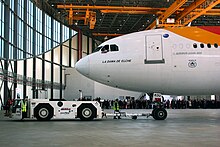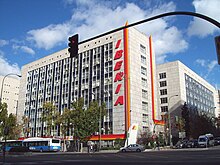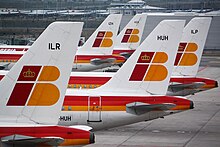Iberia (airline)
| |||||||
| Founded | 28 June 1927 | ||||||
|---|---|---|---|---|---|---|---|
| Hubs | Madrid (Barajas Airport) | ||||||
| Focus cities | Barcelona (El Prat Airport) | ||||||
| Frequent-flyer program | Iberia Plus | ||||||
| Alliance | Oneworld | ||||||
| Subsidiaries | |||||||
| Fleet size | 103 (+27 orders) excl. subsidiaries 170 (+62 orders) inc. subsidiaries excl. shares | ||||||
| Destinations | 120 (38 domestic + 82 international) | ||||||
| Parent company | International Airlines Group | ||||||
| Headquarters | Velázquez, 130, Madrid, Spain[1] | ||||||
| Key people | Antonio Vázquez CEO | ||||||
| Website | iberia.com | ||||||
Iberia Líneas Aéreas de España, S.A., commonly known as Iberia, is the flag carrier airline of Spain. Based in Madrid,[2] it operates an international network of services from its main bases of Madrid-Barajas Airport and Barcelona El Prat Airport.[3]
Iberia, with Iberia Regional (operated by an independent carrier Air Nostrum), is a part of Iberia Group. In addition to transporting passengers and freight, Iberia Group carries out related activities, such as aircraft maintenance, handling in airports, IT systems and in-flight catering. Iberia Group airlines fly to over 102 destinations in 39 countries. Via code-sharing arrangements with other companies, it offers flights to another 90 destinations.[3]
On 8 April 2010, it was confirmed that British Airways and Iberia had signed an agreement to merge,[4] making the combined operation the third largest commercial airline in the world by revenue.[5] Shareholders of both carriers approved the deal on 29 November 2010.[6] The newly merged company, known as International Airlines Group, was established in January 2011, although both airlines will continue to operate under their current brands.[7]
Iberia is currently ranked as a 3-star airline from Skytrax.[8]
History
Iberia, Compañía Aérea de Transportes was incorporated on 28 June 1927 with a capital investment by the financier Horacio Echeberrieta and Deutsche Luft Hansa of 1.1 million pesetas. Flight operations started on 14 December 1927. Within a year, the company was sponsored by the Spanish government to provide postal transport between Madrid and Barcelona. During the dictatorship of Miguel Primo de Rivera, the aviation companies in Spain were combined and became state-controlled as a general interest public utility, coming into effect in early 1928. As a consequence, Iberia was merged into Compañía de Líneas Aéreas Subvencionadas S.A. (C.L.A.S.S.A.) and ceased activities on 29 May 1929. The name "Iberia" continued to be registered by Director-General Daniel de Araoz y Aréjula. As the name "Iberia" was still registered, it was used when operations began in nationalist-held territory towards the end of the Spanish Civil War. Following the Civil War, it became a purely domestic airline.


The airline was nationalised on 30 September 1944 and became part of INI. In 1946, it was the first airline to fly between Europe and South America after WWII, using a Douglas DC-4 flying from Madrid to Buenos Aires.[3] By the Pact of Madrid in 1953, visa requirements were eliminated for US visitors to Spain. This stimulated the start of transatlantic flights between Spain and United States the following year. In addition, the amendments made in Montreal to the Convention on International Civil Aviation on 14 June 1954 were liberal to Spain, allowing mass tourism using charter planes.

By the time of its 50th anniversary in 1981, the Boeing 747 airline carried over 10 million passengers in a year for the first time. In the late 1980s/early 1990s, Iberia also began to build up interests in other Spanish airlines – Aviaco, Viva Air, Binter Canarias and Binter Mediterraneo and Latin American airlines – Aerolíneas Argentinas, Viasa and Ladeco. [citation needed].
In 1987 Iberia together with Lufthansa, Air France and SAS founded Amadeus, an IT company (also known as a GDS) that would enable travel agencies to sell the founders and other airlines' products from a single system.
During 2001 Iberia was privatised and shares were listed on stock exchanges. By 2002, when Iberia celebrated its 75th anniversary, nearly 500 million people had flown with them.
On 5 February 2006 the new Terminal 4 at Madrid Barajas was given over to Iberia and the Oneworld alliance members. This provided much-needed expansion capabilities for Iberia. Iberia is responsible for around 60% of the airport's traffic. In 2005 the airline and its regional branch Air Nostrum transported 21,619,041 passengers to/from Barajas.
In 2009, Iberia reached an agreement to merge with European rival British Airways. This merger was completed by April 2010, creating the International Airlines Group. The newly formed company consisted of British Airways and Iberia as well as their respective subsidiaries and has its main hubs at London Heathrow Airport and Madrid Barajas Airport as well as smaller hubs at Gatwick Airport and Barcelona El-Prat Airport.
Ownership

On 3 April 2001, Iberia was privatised and included in the IBEX-35 stock index of the Madrid stock exchange. The core shareholders are: Caja Madrid– 23.45%, British Airways 13.2%, SEPI– 5.20%, El Corte Inglés– 2.90%.[9] British Airways has raised its stake in Iberia by purchasing American Airlines' remaining shares, reportedly paying £13m for the small shareholding. This increases the total stake in Iberia to around 10% and preserves its two seats on the Iberia board.[10] British Airways also has first right to purchase another 32% of Iberia's shares. Consequently any takeover of Iberia would require the approval of British Airways.

British Airways cannot acquire more than 49% of Iberia as bilateral air services agreements between Spain and non-EU countries require Iberia to remain in overall Spanish ownership (at least 51%) if the airline is to retain its rights to fly to these countries from Spain. While the new EU-US Open Skies deal on air services removes this requirement on all flights between the EU and US by EU airlines, this is not the case for the lucrative Latin American market on which Iberia relies for the majority of its profits.
On 29 July 2008, British Airways and Iberia confirmed they are in merger talks and on 12 November 2009, they confirmed that they had reached a deal. The merger was approved by European regulators in July 2010.[11] Iberia will hold 45% of the newly formed company.
Iberia has 24,348 employees (at March 2007).[3]
Subsidiaries and alliances

Iberia has a 45.85% stake in low-cost carrier Vueling, which is based near Barcelona and a 0.95% share in Royal Air Maroc.[3]
Iberia is allied with American Airlines, Qantas, Avianca, British Airways, PLUNA of Uruguay and Grupo TACA, and on 1 September 1999, the company joined the Oneworld alliance. British Airways owns 55% of its share capital.
Iberia has a codeshare agreement with several Oneworld members: Cathay Pacific on flights from Amsterdam and London Heathrow to Hong Kong, Japan Airlines on flights from Amsterdam to Tokyo Narita and Royal Jordanian from Madrid to Amman, and with LAN Airlines for flights connecting Latin America and most of Europe. Also code share with Malev Hungarian Airlines on the Madrid-Budapest service and several Malev routes within Europe and Russia
Vueling and Clickair, merged together in 2009.
Former subsidiaries
- Aviaco, Aviación y Comercio, S.A. (Aviation and Comerce) was a subsidiary of Iberia mostly for domestic lines. It was founded on 18 February 1948 and operated until 1 September 1999.
Binter was the name of two airlines, both of whom were subsidiaries of Iberia, both airlines flew CN-235's :
- Binter Canarias - was established on 18 February 1988 and started operations on 26 March 1989. It was formed as a subsidiary of Iberia. In late 1999 SEPI (the Spanish state holding company of Iberia) implemented the privatisation of Binter Canarias, but held on to a "golden share", permitting it to authorise any future shareholding deal of more than 25%. However, the airline was wholly owned by Hesperia Inversiones Aéreas, which bought the airline in July 2002. It is now owned by Ilsamar Tenerife (49.81%), Ferma Canarias Electrica (10.44%), Agencia Maritima Afroamericana (10.11%), Flapa (10%) and others (19.6%) and has 406 employees. Some of the owners of Binter Canarias decided to buy Navegacion y Servicios Aéreos Canarios (NAYSA) and to transfer some planes from Binter to NAYSA in order to reduce costs and increase benefits.
- Binter Mediterraneo - created in 1988, in the likeness of Binter Canarias, and subsidiary of Iberia LAE. The airline was based in Madrid and operated a fleet consisted of five CASA CN-235 aircraft. Binter Mediterraneo linked the city of Melilla to Malaga, Almeria, Valencia and in its last year, with Madrid. Binter ceased operations after one of its planes crashed on August 29 of 2001 in the vicinity of Malaga airport while performing the Melilla-Malaga route.[12] acquired by Air Nostrum, another Iberia subsidiary, in 1998 and absorbed its operations. It replaced the remaining CN-235's with ATR-72's.
Services
In 2005, Iberia introduced its new Business Plus Class on its Airbus A340 aircraft.
In March 2009 Iberia announced that during the course of 2009–2011 it would renovate its economy class on all its planes as well as designing a new business class for its long haul planes.
In addition, Iberia is an aircraft maintenance company , servicing its fleet and those of another 48 companies, including some leading European airlines. Iberia is a supplier of aircraft handling services at all Spanish airports; its airline clients number more than 200.
Iberia was a founding partner in the computerised air ticket reservation system, Amadeus, with an 18.28% stake – this was sold in 2005. Iberia is also active as a tour operator through its Viva Tours and Tiempo Libre units, and with Cacesa, it supplies parcel shipment services.
Iberia makes use of e-tickets and encourages customers to print the boarding pass prior to their flight. Travellers with only carry-on baggage can go directly to the boarding gate. e-tickets sales accounted for 93% of all Iberia tickets sold in January 2006. In Spain identification of the traveller by means of an identity document or passport is mandatory for all airlines on all routes, including Spanish domestic ones.
The airline, on European and North African flights, offers the "Tu Menú" buy on board service for economy class passengers. Flights within Europe and Northern Africa which have free food and drinks for economy class passengers, due to length, are those to and from Athens, Cairo, Dakar, Istanbul, Malabo, Moscow, and Tel Aviv.[13]
Destinations

Iberia is the only European Airline to serve Guatemala City, San Salvador and Montevideo. Currently, Iberia is striving to convert Barcelona's El Prat airport into its second major international hub; new long haul routes to Miami and Sao Paulo - where Iberia has codeshare agreements with American Airlines and Gol Airlines, respectively - began on the 29th March 2011.
Codeshare agreements
Iberia has codeshare agreement with the following airlines, * indicates as Oneworld:
|
|
Catering
Gate Gourmet provides Iberia's in-flight catering. Economy class passengers traveling within western Europe have a buy on board food programme called "Tu Menú."[15]
Fleet

Iberia operates an all-Airbus fleet of the following aircraft as of 16 March 2012:
| Aircraft | Total | Orders | Passengers | Notes | ||
|---|---|---|---|---|---|---|
| P | Y | Total | ||||
| Airbus A319-100 | 19 | 2 | 44 | 78 | 122 | |
| Airbus A320-200 | 29 | 17 | 18 | 162 | 180 | |
| Airbus A321-200 | 19 | — | 46 | 154 | 200 | To be possibly retired |
| Airbus A330-300 | — | 8 | 36 | 241 | 277 | Plus 8 options. |
| Airbus A340-300 | 19 | — | 36 | 218 | 254 | To be phased out by Q4 2012[16] |
| Airbus A340-600 | 17 | — | 42 | 300 | 342 | |
| Total | 103 | 27 | ||||
In June 2011, the average age of the Iberia fleet was 8.2 years.[17]
Iberia's livery is a "Eurowhite" scheme, composed of primarily white with red and yellow accents.
Fleet development
Over the years, Iberia operated the following aircraft types:[18][19][20]
Incidents and accidents
See also
References
- ^ "Airline Membership". IATA.
- ^ "Legal notice." Iberia. Retrieved on 25 February 2010. "IBERIA, Líneas Aéreas de España, S.A. with official address at Calle Velázquez no. 130, 28006 Madrid,"
- ^ a b c d e "Directory: World Airlines". Flight International. 2007-04-0s3. pp. 91–92.
{{cite news}}: Check date values in:|date=(help) - ^ "British Airways and Iberia sign merger agreement". BBC News. 2010-04-08. Retrieved 8 April 2010.
- ^ "BA seals long-awaited Iberia deal". Reuters UK. 2010-04-08. Retrieved 8 April 2010.
- ^ http://uk.finance.yahoo.com/news/Timeline-BA-Iberia-reuters_molt-1258343248.html?x=0
- ^ "IAG shares begin trading, replacing BA and Iberia". BBC News Online. 24 January 2011. Retrieved 2 January 2012.
- ^ http://www.airlinequality.com/Airlines/IB.htm
- ^ Participaciones significativas del Grupo Iberia http://grupo.iberia.es/portal/site/grupoiberia/menuitem.5dcd178a7f0a73be19736c10d21061ca/
- ^ Airliner World January 2007
- ^ "BA and Iberia secure European approval for merger". Flight Global. 2010. Retrieved 2010-07-18.
- ^ ASN Aircraft accident CASA 235-200 EC-FBC Málaga Airport (AGP) Aviation Safety Network
- ^ "Economy." Iberia. Retrieved on 13 December 2011.
- ^ http://www.nasdaq.com/aspx/stock-market-news-story.aspx?storyid=201107080525dowjonesdjonline000281&title=air-berliniberia-start-code-share-agreement
- ^ "Tu Menú." Iberia Airlines. Accessed October 11, 2008.
- ^ Introduction to IAG, p. 66
- ^ Iberia Fleet Age
- ^ Iberia fleet development listing at airfleets.net
- ^ http://active.boeing.com/commercial/orders/displaystandardreport.cfm?content=default.cfm&pageid=m25064&optReportType=Customer&cboCustomer=IBE
- ^ http://www.hosteltur.com/noticias/4990_iberia-realiza-ultimo-vuelo-boeing-727-ruta-madrid-barcelona.html






